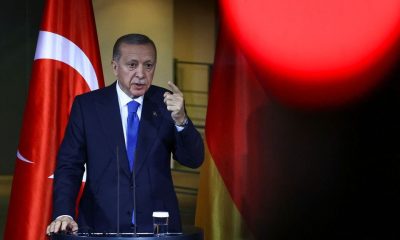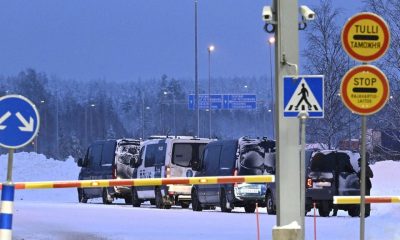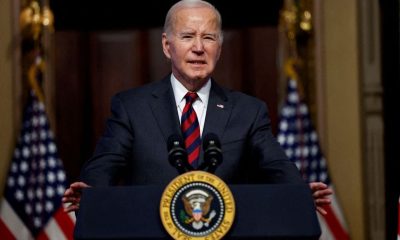Terror
Boston Marathon Bomber Dzhokhar Tsarnaev sentenced to Death
Heaps of those affected personally by one of the most tragic terrorist attacks on U.S. soil, gathered outside Boston’s federal courthouse this afternoon, to receive the long awaited sentence for 21 year old, Dzhokhar Tsarnaev, conspirator and placer of one the backpacks filled with shards of shrapnel that detonated near the finish line of the Boston Marathon in 2013.
“It was the most closely watched terrorism trial in the U.S. since the Oklahoma City bombing case two decades ago.” CBS News reported.
Amongst the many keen observers of the trial were Bill and Denise Richard, parents of 8 year old son, Martin, who lost his life in the attack, along with their daughter Jane, who was merely 7 at the time of the attack, forcibly losing her left leg as a result of the bombs impact.
Given a choice, the Richard’s voted to sentence Tsarnaev to life in prison as opposed to the death penalty fearing, “ Appeals would drag out a death sentence for years, making it hard for them to move forward with their lives” (NewYorkTimes).
First hand accounts of the trial describe Tsarnaev as impervious, dressed in khakis with an ominous colored shirt, with the sleeves rolled up, and a smirk on his face.
Bewildered by his nonchalantness, the jury denied several pleas by the defense to have the trial postponed to a later date, or moved out of Boston.
Officially charged with 30 criminal counts, including the murder of M.I.T. campus police officer, Sean Collier, in the aftermath standoff with authorities days after the actual attack, the jury found Dzhokhar Tsarnaev guilty, and sentenced him to the death penalty. U.S. attorney, Carmon Ortiz, emphatically affirmed the court’s ruling, stating in a press conference, “ Today the jury has spoken. Dzhokhar Tsarnaev will pay for his crimes with his life.”
Tsarnaev had originally pleaded not guilty, and with any death penalty sentencing comes an automatic appeal.
Boston police commissioner, William Evans, commented on the trial’s impact on the attack’s victims and their families by saying, “It was a tragedy. I don’t think there are any winners here. Four families lost their loved ones. I think everyone gets some satisfaction.”
The U.S. district judge, George O’Toole Jr., is set to pose a formal sentencing at a later date, specifying the time and date of his execution, in which victims of the attack, and Tsarnaev are given the opportunity to address the court.
POLITICS
Exclusive: Taliban weighs using U.S. mass surveillance plan, met with China’s Huawei.
An interior ministry spokesman told Reuters that the Taliban are developing a large-scale camera surveillance network for Afghan cities that may involve adapting an American plan before their 2021 withdrawal. This development comes as authorities work to supplement the thousands of cameras already positioned throughout the capital, Kabul.
The Taliban government, which has stated publicly that it is primarily concerned with reestablishing security and suppressing the Islamic State, which has claimed responsibility for numerous significant attacks in Afghan towns, has also spoken with Chinese telecom equipment manufacturer Huawei about possible collaboration, the spokesman added.
According to readouts from such discussions, the Taliban’s involvement with several other countries, including the U.S. and China, is centered on preventing assaults by international militant groups, particularly well-known organizations like the Islamic State. However, some observers doubt the regime’s ability to pay for the initiative, and rights groups are worried that any funding will be used to repress demonstrators.
There have been no prior reports on how the Taliban seeks to increase and handle mass monitoring, including acquiring the U.S. plan.
According to Ministry of Interior spokesman Abdul Mateen Qani, the mass camera rollout, which will concentrate on “important points” in Kabul and other locations, is a component of a new security policy that will take four years to implement.
We are currently working on a security map of Kabul, which is taking a long time and the help of security professionals, he said. We already have two maps, one from the United States made for the previous administration and the other for Turkey.
He made no mention of the creation date of the Turkish proposal.
Speaking on behalf of the State Department, the United States claimed that it was not “partnering” with the Taliban and that it had “made clear to the Taliban that it is their responsibility to ensure that they give no safe haven to terrorists.”
Requests for comment from a representative of the Turkish government were not answered.
Qani claimed that in August, the Taliban and Huawei [RIC: HWT. U.L.] had a “simple chat” regarding the potential network, but no agreements or concrete plans had been made.
According to a source familiar with the conversations, Bloomberg News reported in August that Huawei had reached a “verbal agreement” with the Taliban regarding a deal to set up a surveillance system.
In September, Huawei informed Reuters that “no plan was discussed” at the meeting.
However, she said, “China has always supported the peace and reconstruction process in Afghanistan and supported Chinese enterprises to carry out relevant practical cooperation.” A Chinese Foreign Ministry spokesperson said she was unaware of any specific negotiations.
POWER CUTS AND RIGHTS QUESTIONS
According to the Taliban, approximately 62,000 cameras throughout Kabul and other cities are watched over from a centralized control room. The prior administration, which mainly relied on Western-led international forces for security, claimed that the last significant modification to Kabul’s camera system occurred in 2008.
In January 2021, when NATO-led international forces began to withdraw progressively, then-vice president Amrullah Saleh promised his administration would introduce a significant overhaul to Kabul’s video monitoring system. He informed reporters that the NATO coalition supported the $100 million initiative.
“The arrangement we had planned in early 2021 was different,” Saleh said to Reuters in September, adding that the “infrastructure” for the 2021 plan had been damaged.
It was unclear whether the plan Saleh referred to was comparable to those the Taliban claimed to have obtained and whether the administration would alter them.
A surveillance system would be “useful for the Taliban as it seeks to prevent groups like the Islamic State from attacking Taliban members or government positions in Kabul,” according to Jonathan Schroeder, a specialist on Afghanistan with the Center for Naval Analyses.
The Taliban maintains constant roadblocks and security force vehicles to monitor urban areas actively.
Rights activists and regime critics fear increased surveillance may target protestors and members of civil society.
The Committee to Protect Journalists reports that at least 64 journalists have been jailed since the takeover, though the Taliban rarely confirms arrests. According to demonstrators, videos, and Reuters witnesses, security personnel in Kabul violently dispersed protests against limitations on women.
Mass surveillance programs being implemented “under the guise of ‘national security’ set a template for the Taliban to continue its draconian policies that violate fundamental rights,” according to Matt Mahmoudi of Amnesty International.
The Taliban vehemently disputes that an improved surveillance system will violate Afghans’ human rights. According to Qani, the system is equivalent to those used by other big cities and will be run by Islamic Sharia law, which forbids recording in private areas.
Security analysts claim that the plan confronts real-world difficulties.
Daily power outages in Afghanistan make it unlikely that cameras connected to the main grid deliver reliable feeds. According to the government-owned power company, just 40% of Afghans have access to electricity.
After a severe economic downturn and the removal of considerable aid following their takeover, the Taliban also needed to find finance.
According to the Taliban army chief, the administration claimed in 2022 to have an annual budget of more than $2 billion, most of which goes toward defense.
LIBERATION RISKS
A few months before the conversation with Huawei, China met with Pakistan and the temporary foreign minister of the Taliban. During that time, the parties emphasized their commitment to counterterrorism cooperation. Another important component of the 2020 troop departure agreement that the United States made with the Taliban is dealing with militancy.
The East Turkestan Islamic Movement (ETIM), an armed separatist group operating in China’s western Xinjiang region, has drawn China’s public concern. According to security sources and U.N. data, ETIM probably has a few militants in Afghanistan. ETIM was unavailable for comment.
Foreigners in Afghanistan have also received threats from the Islamic State. Last year, its fighters stormed a popular hotel with Chinese executives, injuring several Chinese nationals. One of its attacks also resulted in the death of a Russian official.
The Taliban asserts that there is no threat to their authority from militancy and that no assaults would originate in Afghanistan. They have made raids on Islamic State cells in Kabul publically known.
Thomas West, the U.S. Special Representative for Afghanistan, stated at a public seminar on September 12 that Taliban attacks in Afghanistan had eliminated at least eight significant officials of the Islamic State in Afghanistan, some of whom were in charge of foreign plotting.
According to a U.N. monitoring assessment from July, there may be as many as 6,000 Islamic State fighters and their families in Afghanistan. Urban surveillance, according to analysts, won’t completely solve their existence.
According to Schroden, the eastern mountainous regions of Afghanistan are where Islamic State fighters’ “home bases” are located. Therefore, while cameras in cities may help avoid attacks, they are unlikely to contribute to their eventual defeat significantly.
AFRICA
President’s “Non-Starter” Deal Will Not End Shutdown
This week, shutdown polls showed the American public blame President Trump for the government shutdown. To divert Americans’ attention elsewhere, President Trump tried to make a deal with Democrats on Saturday. Among other elements, the deal consists of three years’ legislative relief to DACA recipients and a three-year extension of temporary protected status for 300,000 immigrants whose protected status is about to expire. In exchange for these provisions, $5.7 billion border wall funding will finally be paid for. The so-called deal is a non-starter because it contains the wall House Speaker Pelosi refuses to compromise on. Moreover, Democrats seek to reopen government before beginning negotiations on border security. Democrats are presenting a united front and refusing to budge on the wall together, at least until the government is opened.
To Pelosi, the wall is an expensive and unnecessary item border security can do perfectly fine without. To President Trump, the wall is an integral part of his campaign promise and essential to seal off the border, stopping illegal crooks and helping border security officials do their jobs.
Support for the wall is clearly divided along partisan lines. Many Republican lawmakers, including Senate Majority Leader Mitch McConnell, supported President Trump’s latest proposal. McConnell said he will floor Trump’s proposal in the Senate next week. Sen. Mitt Romney is also in favor of the proposal. House Republicans too considered Trump’s deal to be bipartisan, fair, and reasonable.
Speaker Pelosi said any one item in the deal was not likely to pass the House, let alone the compilation of all items. Moreover, Trump’s proposal does not offer a permanent solution to Dreamers and TPS recipients. Dreamers and TPS recipients had their protections initially removed by President Trump. President Trump’s deal with the Democrats can hardly be called a deal at all considering the Democrats were not consulted before Trump’s announcement and none of their policy demands were met. His proposal is a consolidation of items Democrats previously voted for and band-aid solutions to Democratic immigration priorities.
Other Democrats such as Sen. Tim Kaine and Mark Werner, both of whom represent Virginia where many federal workers reside, were displeased President Trump did not address the sufferings of federal workers going without pay. Without their paychecks, federal workers, who tend to be paid less overall, can barely make ends meet with mortgage and child care payments. There is increasing dependence on food banks. The government shutdown enters its 29th day.
Featured image via Flickr/The White House
AFRICA
Young Man Who Targeted the White House Arrested
US Attorney for the Northern District of Georgia, Byung J. Pak, announced the arrest of a man plotting to blow a hole through the White House for access and subsequently corner people inside with semi-automatic rifles. The backpack he was supposed to wear would have contained a bomb for him to become a “martyr”.
Hasher Taheb, 21, is from Cumming, Georgia. He plotted to attack the White House, the Statue of Liberty, and other locations in Washington, D.C. Taheb was investigated by the Atlanta Joint Terrorism Task Force and the FBI for a year after a community member gave local authorities the hint Taheb was becoming a dangerous radical. The tip, given in March 2018, said Taheb had, “become radicalized, changed his name, and made plans to travel abroad.”
In July, Taheb applied for a US passport and put his car on sale. Taheb told an FBI informant who showed interest in buying the car that he was selling the car to pay for his trip abroad to ISIS-controlled territories. He teamed up with this FBI informant and relayed to him his passion for jihad along with the targets he had in mind.
On December 2, Taheb met with the informant and an undercover FBI agent. He communicated his desire to be a “martyr” and inflict as much damage as possible in the US. Taheb drew a diagram of the West Wing in the White House and requested assistance in obtaining weapons and explosive devices from the undercover agent on December 7. On December 15, Taheb uploaded a 40-page manifesto about jihad to Google Docs and started a group chat with the informant and undercover agent for discussing imminent attacks planned.
On Saturday, Taheb met the FBI informant and informed him he was going to initiate attacks on Thursday. On Wednesday, Taheb and the two FBI associates conferred in a store parking lot located in Buford, Georgia to exchange their automobiles for rifles and explosives. A second FBI informant joined them and instructed Taheb on how to use the weapons. Taheb was arrested at the scene after he gave away his car keys and took the explosives he was promised, transferring them to a rental vehicle. Chris Hacker, head of Atlanta’s FBI branch, said authorities think Taheb was acting alone aside from the FBI associates Taheb expected to carry out his plans with.
Taheb appeared in an Atlanta court, charged with attempts to damage federal properties using improvised explosives. Pak said prosecutors will bring the case before a grand jury. Taheb will next appear in court on January 24 at 3:00 p.m. ET.
Featured image via Flickr/The White House
-

 Europe7 months ago
Europe7 months agoRussia’s Shoigu accuses the West of seeking to expand the Ukraine war to the Asia-Pacific.
-

 Geopolitics & Foreign Policy6 months ago
Geopolitics & Foreign Policy6 months agoTurkey’s Erdogan says he may visit Egypt soon, discuss Gaza patients -media.
-

 America8 months ago
America8 months agoRepublican US House to hold first Biden impeachment inquiry hearing
-

 Geopolitics & Foreign Policy6 months ago
Geopolitics & Foreign Policy6 months agoRussia deploys new nuclear missile in Kaluga region – RIA
-

 Geopolitics & Foreign Policy6 months ago
Geopolitics & Foreign Policy6 months agoCeasefire takes hold in Gaza ahead of hostage release; aid enters enclave.
-

 Global Issues & Cooperation9 months ago
Global Issues & Cooperation9 months agoHuman rights in Russia have ‘significantly deteriorated’ – UN expert.
-

 Gender, Sexuality & Identity8 months ago
Gender, Sexuality & Identity8 months agoGreenland women ask Denmark for compensation over involuntary birth control.
-

 ECONOMY6 months ago
ECONOMY6 months agoFinland will sign a defense pact with the US.


















